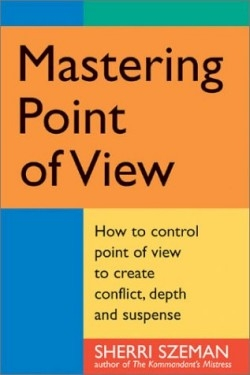Mastering Point of View
Who’s afraid of point of view? Nearly every writer
who sets pen to paper! The author, Professor of English at Central State University in Ohio, and author of Only With a Heart and The Kommandant’s Mistress, winner of the Janet Kafka prize, asks this question at the outset, knowing that point of view can make or break a narrative. It is important, since it is the medium through which a story is told; it is difficult, but not impossible, to master and is satisfying to both reader and writer when it is achieved.
Szeman’s book is a practical, usable guide geared towards fiction writers. She explains the different types of point of view such as first and second person: Outer Limited, in which the reader enjoys the fly-on-the-wall view, since the narrator sees and hears all; Unlimited, which is totally omniscient and places no restrictions whatsoever on time, place, or perspective; and Inner Limited, where the narrator “speaks” in the first person, but the writing is in the grammatical third person form and the combo form. This variable and flexible point of view is commonly used in mystery narratives.
Szeman debunks ten “myths” of point of view strategy held by many a struggling writer, such as: first person point of view is easier to write; each time you describe a different character you change point of view; literary fiction is always written in first person point of view; and writers can’t switch point of view within a narrative. The format is highly organized with demarcated boxes containing a tip, including a writing exercise, an example from a piece of literature, or the author’s expert advice.
Refreshingly, Szeman’s tone is neither preachy in its efforts to instruct nor too academic to make sense on the first read. In fact, she seems to disdain the propounded academic theories of point of view, which have served only, in her opinion, to obfuscate the understanding and implementation of the point of view strategy in a work of fiction. She stresses the importance of writing for an actual (rather than imagined) audience and dares and encourages the writer to brave constructive criticism.
The glossary and bibliography are practical and helpful, making the book both a guide and reference book to be consulted repeatedly. Though bookstore shelves are crammed with how-to writing books, very few seem to give such honest, practical, and focused guidance as this one does. Fiction writers will benefit from this book; Szeman knows what she is writing about and shares it in a readable way.
Disclosure: This article is not an endorsement, but a review. The publisher of this book provided free copies of the book to have their book reviewed by a professional reviewer. No fee was paid by the publisher for this review. Foreword Reviews only recommends books that we love. Foreword Magazine, Inc. is disclosing this in accordance with the Federal Trade Commission’s 16 CFR, Part 255.

